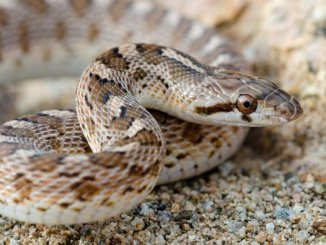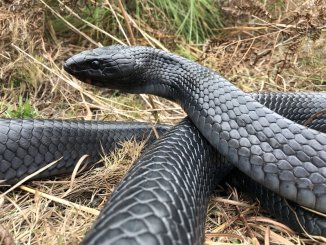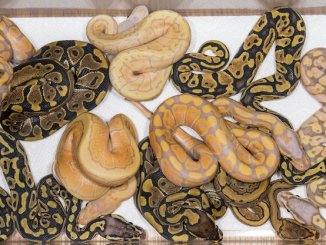The Colombian rainbow boa is a nonvenomous species of rainbow boa hailing from South America. The snake is light brown with dark brown markings, and its scales have a rainbow iridescent sheen when exposed to light.
Caring for a Colombian rainbow boa is easy because the snake is a manageable size, has a tame and placid temperament, and has low care needs.
Colombian Rainbow Boa Overview
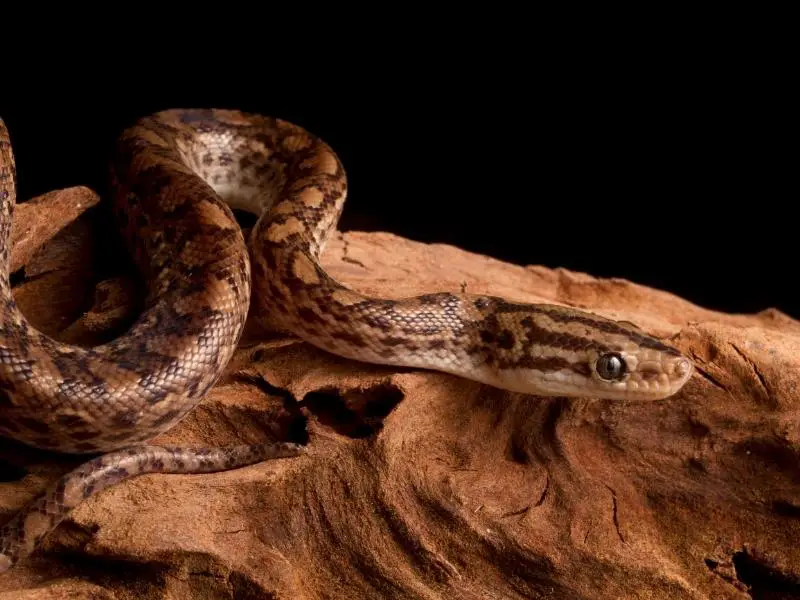
| Common name | Colombian rainbow boa, brown rainbow boa, slender Colombian boa |
| Scientific name | Epicrates maurus |
| Natural habitat | Humid rainforests and dry coastal clearings in and around Colombia, South America |
| Adult size | 50–72 inches |
| Average lifespan | 17–20 years |
| Diet | Carnivore |
| Housing | Minimum 30 gallons, 70–85°F, 75%–85% humidity |
| Experience level | Beginner |
Origin
Rainbow boas are found across South America, and the five different rainbow boa species are named after their regions: Brazil, the Caatinga region of Brazil, Colombia, Argentina, and Paraguay. The Colombian rainbow boa (Epicrates maurus) originates in Colombia.
Colombian rainbow boa juveniles are semi-arboreal and climb trees to escape danger, but the boas become mainly terrestrial as adults. Colombian rainbow boas are common in the wild, especially around rivers and streams — the snakes are capable swimmers.
Appearance and Behavior
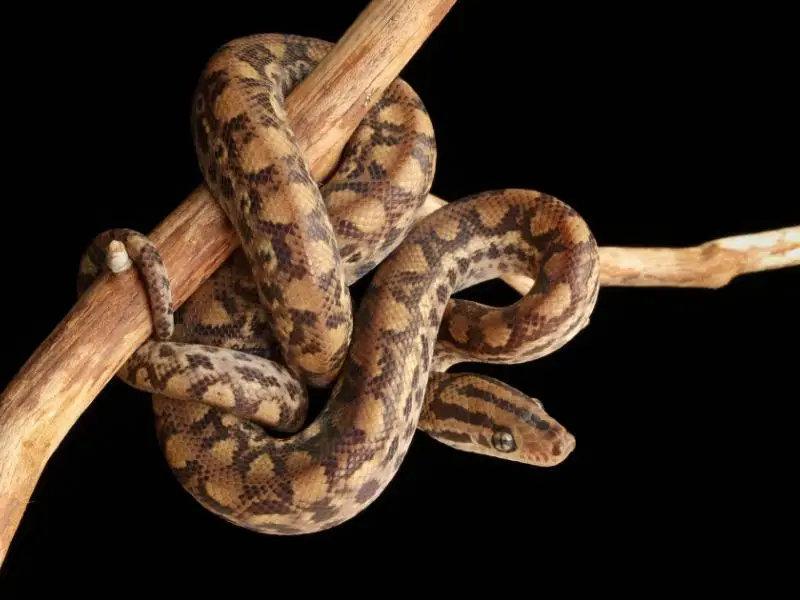
The Colombian rainbow boa is a light brown snake with dark brown vertebral patterning. Its light color sets this snake apart from rainbow boas in other regions. The snake has a lighter, more uniformly-colored belly than the rest of its body. The snake’s most prominent feature is its shiny scales, which shimmer in a spectrum of colors under bright lighting.
Male Colombian rainbow boas are shorter and slimmer than females, but females are less muscular than males.
Size and Lifespan
The average length of a female Colombian rainbow boa is 60–72 inches, while males grow to 50–65 inches. Colombian rainbow boas live for 17–20 years. With proper care, the snakes can live beyond 20 years.
Temperament
Colombian rainbow boas are placid snakes that can be easily tamed and enjoy regular handling. The snakes prefer to live alone, but they can be housed in twos as long as the enclosure is big enough and has enough hides.
This rainbow boa species becomes stressed when housed in noisy or unsanitary environments. The snake is known to be nippy when it’s scared, but its bite is nonvenomous.
Housing Colombian Rainbow Boas
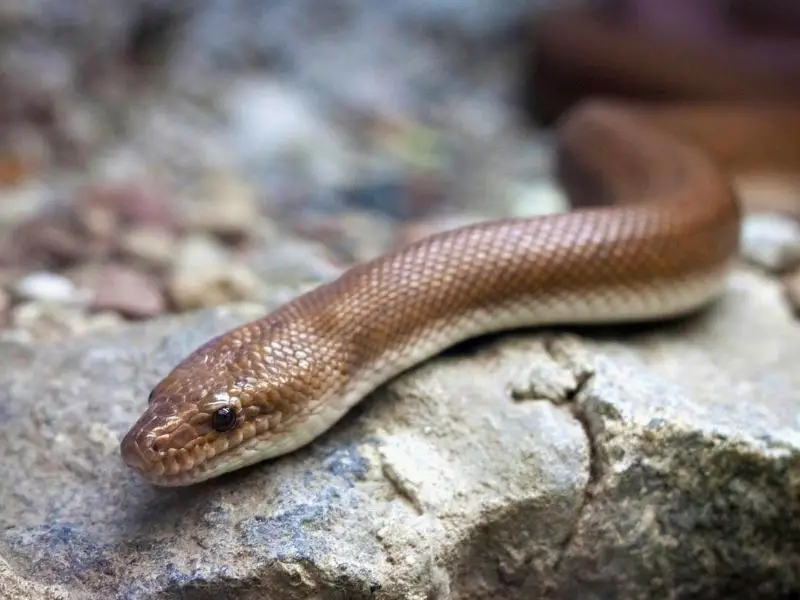
The Colombian rainbow boa’s natural habitats are humid rainforests and dry coastal clearings in and around Colombia. Mimic the snake’s natural habitat in captivity by providing a heated, vegetated enclosure.
The best type of enclosure for a Colombian rainbow boa is a wooden vivarium, which insulates heat easily temperature controlled.
Enclosure size
The minimum dimensions for a Colombian rainbow boa’s enclosure are 48 inches long by 18 inches tall. An enclosure of this size should accommodate the snake’s length, and provide enough height for climbing branches and enough length for a temperature gradient.
Lighting
The Colombian rainbow snake doesn’t need special UVB light to absorb calcium. If the enclosure is housed in an area that gets at least eight hours of natural sunlight per day, the main section of the enclosure doesn’t need additional lighting at all.
The hot section of the tank should have a basking lamp on the underside of the roof, covered by a protective cage to prevent the snake from getting too close to it.
Temperature and Humidity
The required temperature for a Colombian rainbow snake enclosure is 70–85°F. Provide a temperature gradient, with separate hot and cold sections in the vivarium, to allow the snake to regulate its temperature.
Two-thirds of the tank should be about 75°F during the day and 70–72°F at night to replicate the cool evening temperatures in the snake’s wild habitat. The other one-third of the tank should be the basking section, with a warmer temperature of 85°F. Use a basking light and a heating pad to heat this hot section of the enclosure.
Monitor and control the temperature in the hot and cold sections of the enclosure with a vivarium thermometer.
The enclosure’s humidity should be 75%–85%. Maintain this humidity level by misting the tank several times per day or by using an automated mister. Placing a water bowl in the center of the enclosure also helps maintain high humidity levels.
Use a hygrometer to monitor humidity in the enclosure. Optionally, increase the humidity levels to 90% to support the snake while it’s shedding.
Substrate and Decoration
Ideal substrates for a Colombian rainbow snake enclosure are orchid bark, peat and bark mix, coconut fiber, and Cypress mulch. These substrates retain moisture, are resistant to mold, and aren’t abrasive.
Sphagnum and green moss can be used to give the enclosure a natural feel. Newspaper is a low-maintenance, easy-clean option that can be removed and refreshed as often as necessary, but it’s not as appropriate for this snake’s enclosure as other substrates are because it doesn’t retain humidity.
Artificial plants can be used to create a jungle-like environment in the tank. Live plants like ferns, orchids, and spider plants are suitable for humid enclosures, but keep live plants are more difficult to maintain than artificial plants. Place one or two large logs and branches in the enclosure for the snake to climb.
Other good decorations for Colombian rainbow snake tanks are hides and caves for the snake to sleep in. Large, flat rocks can be placed in the hot section of the enclosure to provide a warm spot for the snake to bask. Leave a shallow water bowl in the middle of the tank for the snake to drink from.
Cleaning
The high-humidity Colombian rainbow boa’s enclosure is susceptible to mold and bacteria growth, which can be prevented with regular cleaning.
Spot clean the enclosure once a day. Clean and refill the water bowl, and scoop out the soiled substrate and leftover food. Once a week, thoroughly clean the enclosure.
Before doing a deep clean, transfer the snake to a temporary enclosure and remove all the substrate and decorations from the tank. Wipe down all inside surfaces with a sponge dipped in soapy water. Soak the decorations in a bucket of hot, soapy water, then rinse them off under running water.
Wait until the enclosure dries, then add a fresh layer of substrate, return the plants and decorations, and transfer the snake back into the enclosure.
Don’t use harsh chemicals for cleaning the snake’s enclosure because these could cause respiratory issues in the snake.
Colombian Rainbow Boa Care
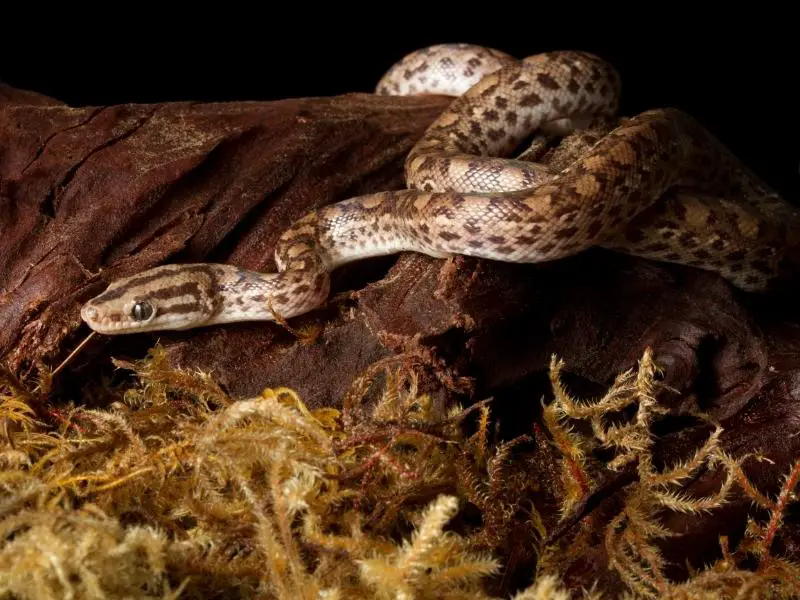
Caring for a Colombian rainbow boa is easy because the snake is hardy and a good eater in captivity. Feed Colombian rainbow boas a healthy, high-protein diet, and keep the enclosure clean to reduce the risk of health issues.
Food and Water
In the wild, Colombian rainbow boas feed on small reptiles, mammals, and birds. The snakes don’t need such a varied diet in captivity — a diet of thawed, frozen mice and rats provides all the nutrients these snakes need. Don’t offer live foods to the boa because live animals can injure the snake in an enclosed environment.
Feed a Colombian rainbow boa one mouse or rat every two weeks. Snakes younger than six months old should be fed one pinkie mouse once a week to support the snakes’ rapid growth.
Colombian rainbow boas need constant, daily access to clean, freshwater. Use a flatwater bowl that’s easy for the snake to enter and exit.
Handling
Handling a rainbow Colombian boa is relatively safe for experienced adults because the species is calm and easily tamed. The snake shouldn’t be handled by children or people who aren’t experienced with handling large constrictors because of this snake’s large size and nipping tendency.
Don’t handle a Colombian rainbow boa for its first week in your home, to allow it to settle into its new environment. Wash your hands before handling the snake, then follow these steps:
- Accustom the snake to your presence by reaching your hands into the tank and laying them flat on the substrate, avoiding fast movements. Do this several times a day for one week
- If the snake doesn’t respond nervously to your presence by the seventh day, you can attempt handling. Slide one hand under the last two-thirds of the snake’s body, and the other hand behind the head. Slowly lift the snake up without leaving the tank, then gently lower your arms back down and slide your hands out from underneath the snake
- Repeat handling attempts twice a day for one week
- Once the snake is accustomed to your touch, lift it fully out of the tank. The snake may loosely wrap itself around your arms to feel secure. If the snake climbs towards your neck, gently push its body back towards your arms
- Handle the Colombian rainbow boa for a maximum of 15 minutes, once a day
Sudden movements and loud noises stress the snake, so handling should always be in calm environments by gentle, calm, experienced people. Children should be supervised at all times.
Common Health Issues
There are several common health issues known to affect Colombian rainbow boas in captivity:
Respiratory Infections
Improper temperatures and humidity levels, and unsanitary environments cause respiratory infections in Colombian rainbow boas. Signs of respiratory infections include nasal discharge, mucus around the mouth, wheezing, lethargy, and loss of appetite. Avoid respiratory infections by ensuring the tank is cleaned frequently and the temperature and humidity are correct. Speak to your veterinarian about antibiotic treatments for an infected snake.
Scale Rot
Scale rot is a term for several problems affecting a snake’s skin, including bacterial abscesses, blister disease, and ulcerative dermatitis. Unsanitary living environments, improper habitat regulation, and vitamin A or C deficiency are all known to cause scale rot in Colombian rainbow boas. Symptoms of scale rot are cracked or crusty scales, redness or swelling on the skin, and loss of appetite. Treat scale rot by cleaning and sterilizing the enclosure and adjusting the temperature if necessary, and soaking the infected area in a betadine solution or a trusted reptile skin cleanser.
Parasites
Common reptile parasites, such as snake mites, enter an enclosure through infected cage mates, food, substrate, or water. Snakes with parasites exhibit symptoms including restlessness, skin irritation, loss of appetite, difficulty shedding, abnormal behavior, rapid weight loss, and dehydration. The exact symptoms depend on the type of parasite the snake has. To treat a Colombian rainbow boa snake with parasites, sanitize the entire tank and use vet-prescribed medications.
Breeding
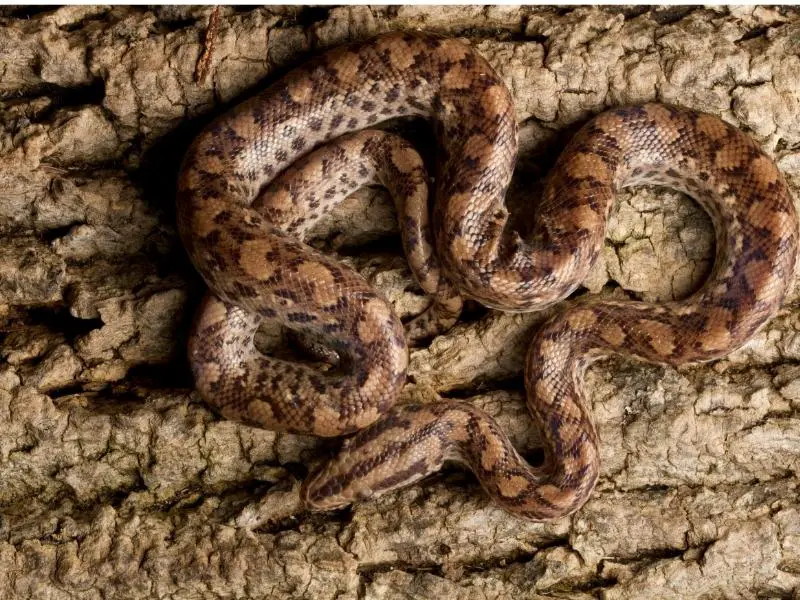
Colombian rainbow boas are easy to breed in captivity. The snakes reach sexual maturity at two and a half to four years old.
To breed a pair of Colombian rainbow boas, follow these steps:
- Select a healthy adult male and female snake for breeding
- Set up a separate breeding tank with the same decorations and conditions as the snakes’ home tanks. Condition the snakes in their home tanks for six weeks to prepare them for breeding. Over this time, gradually decrease the temperature of the snakes’ home tanks and the breeding tank to 65°F
- Introduce both snakes to the breeding tank after six weeks. After several days, the snakes should copulate. The male can be returned to his home tank once breeding is complete
- Continue to offer the female small meals throughout her six-month gestation period, and slowly increase the temperature of the breeding tank to 75°F. The female will have become gravid (pregnant) and stopped eating as much food as usual
- Move the female back to her home tank when her babies are born, and place the hatchlings in a small tub with a damp paper towel, in the breeding tank. The female will have given birth to between 10 and 20 live babies
- Feed the hatchlings several days after birth, when they shed for the first time. Feed the snakes one pinkie mouse each, twice a week, until the snakes reach six months old and can be fed adult food and moved to their own separate tanks
Choosing and Buying a Colombian Rainbow Boa
The cost of a Colombian rainbow boa is $200–$350. Females are more expensive than males because females are more in demand for breeding. It’s recommended to buy a Colombian rainbow boa from a reputable breeder.
Colombian rainbow boas are fairly common to buy in the US. When buying a snake from a breeder, visit the snake to check for signs of good health, such as clear, alert eyes, smooth, shiny scales, and healthy feeding habits. Avoid snakes with swelling, lumps, or scabs on their bodies, or discharge from the eyes, nose, or mouth.

